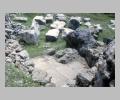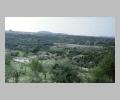| Summary: | Major sanctuary in the North Aegean region, located on the island of Samothrace. |
| Type: | Sanctuary |
| Region: | Sporades |
Periods:
Archaic
Classical
Hellenistic
Roman
Physical:
The Sanctuary of the Great Gods is located half a kilometer inland from the N coast of Samothrace and just W of the city that the Greek colonists fortified in the Archaic period.
The sanctuary occupied a ridge between two streams in the Archaic and Classical periods and expanded W to an adjacent ridge by the end of the Hellenistic period.
Structures on the E ridge centered around the original pre-Greek cult features and included: the Arsinoeion (the largest rotunda of ancient Greece), that sheltered the earliest rock altar of the sanctuary; the Anaktoron which served as a hall for the first initiation into the Mysteries; the Hieron where the higher initiation ceremonies were performed; the Hall of Votive Gifts, and the Altar Court. Later structures to the W included a large stoa, the theater, and the Nike Fountainhouse.
Description:
When the Aeolian Greeks colonized the island of Samothrace at ca. 700 B.C., they adopted and Hellenized the existing cults and the religious center W of their new city. The original rock altar of the Mother Goddess and other features and elements of the fertility and mystery cults were encorporated into the enlarged sanctuary and the Thracian language continued to be used in religious rituals up to the 1st century B.C.
In the 6th century B.C. the political power of Samothrace reached its peak, but it was in the 5th century, when the island was subject to the Delian League, that the Sanctuary of the Great Gods began to grow in international repute.
During the Hellenistic and Roman periods the sanctuary grew to its largest extent and became the chief religious site in the N Aegean region. The fame of the cult of the Mysteries at Samothrace was surpassed only by that at Eleusis.
In the 3rd century B.C. the first marble structures were added to the site and during the 3rd and 2nd centuries B.C. the Arsinoeion rotunda, the Ptolemaion Gateway, and the theater were constructed as the area of the sanctuary was extended to the W.
In 84 B.C. the sanctuary was plundered by pirates, but it was restored with Roman aid. The cults continued to function, but after an earthquake in A.D. 200 the sanctuary began to decline. Cult activity was halted in the late 4th century A.D. and the final destruction occurred with an earthquake in the 6th century A.D.
Exploration:
G. Deville and E. Coquart excavated in 1866. Excavations by the Austrians Conze and Hauser in 1873 and Niemann and Benndorf in 1875. The French School excavated under Salac and Chapouthier in 1923-1927. Since 1938 (with a break during the war years) excavations have been conducted by New York University, directed by K. Lehmann until his death in 1960 and since then by P. Lehmann and James McCredie.
Sources Used:
Other Bibliography:





